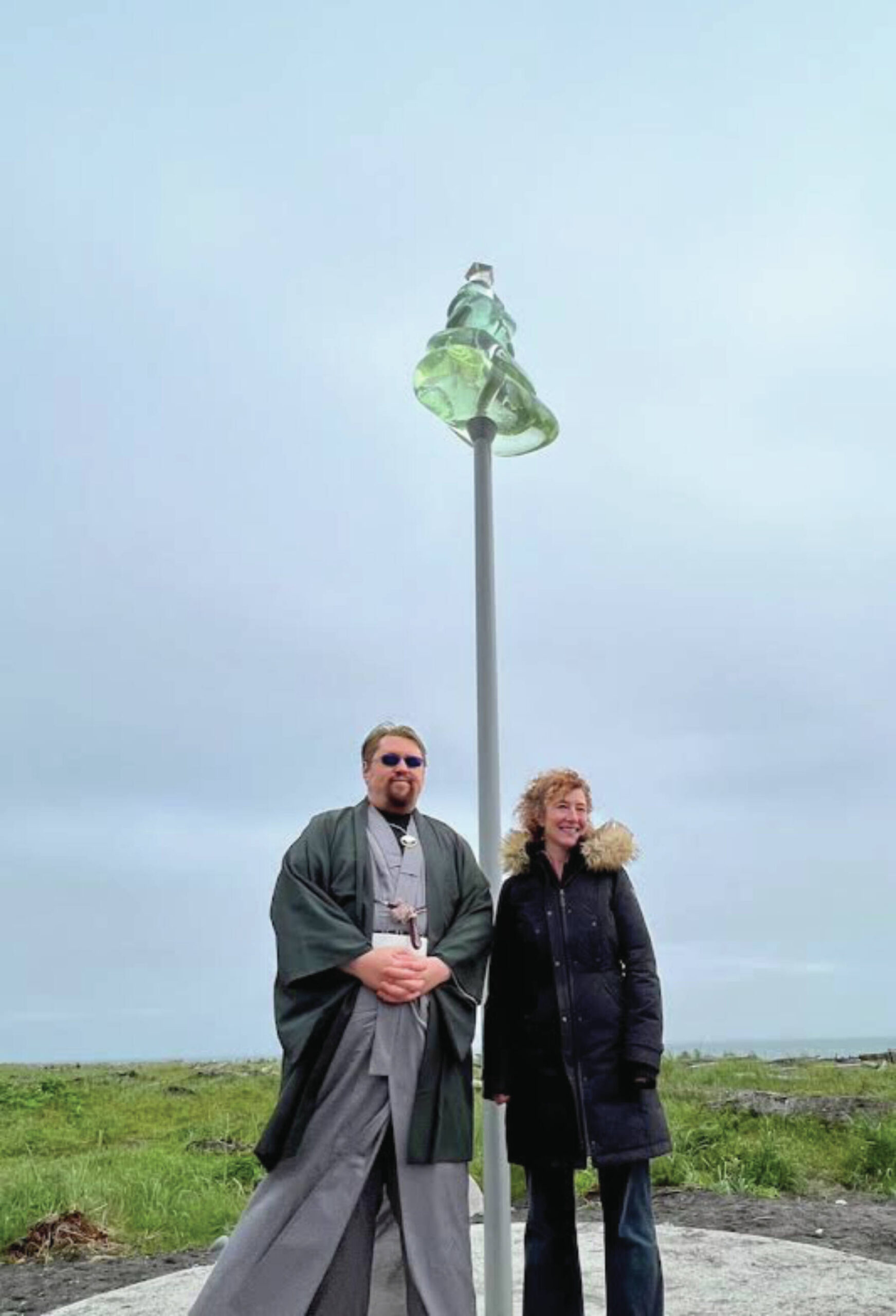On the June 21 summer solstice, Bunnell Street Arts gallery hosted a reception at Bishop’s Beach for the installation of “Tuyanitun: Tuggeht,” a sculpture created by local artist Argent Kvasnikoff, a member of the Ninilchik Tribe of Alaska.
The sculpture, resembles a stack of smooth glass stones on top of a pole, was commissioned as a land acknowledgement piece of art and is now a part of the City of Homer’s Municipal Art Collection.
In 2020, City Council member Donna Aderhold presented Resolution 20-079, passed the Council unanimously and was adopted Sept. 14, 2020. The description of the sculpture from the resolution compares components of the art as “individual parts of a larger concept that pays tribute to the ancient Dena’ina system of navigation.”
“The sculpture is composed of graduated naturalistic shapes to mimic the ch’wala (boreal spruce) and tinitun qualnigi (stone trail markers) used to mark trails between settlements, campsites and important spiritual places, along with their respective place names, the sculpture will also display the name of the general traditional direction that point is located in,” the resolution states.
Asia Freeman, Artistic Director of Bunnell Street Arts Center, opened the reception with acknowledgement of the many individuals and organizations in the Homer and lower Kenai Peninsula area who provided support for the multiyear community sculpture project. Her recognition included staff and Board of Bunnell, The Ninilchik Tribal Council, the City of Homer, and several members of the city staff, public works and park.
Funding support for the project also came from Alaska Community Foundation Social Justice Fund, Alaska State Council on the Arts, Cook Inlet Tribal Council, National Endowment for the Arts, National Performance Network, the Rasmuson Foundation, the Ninilchik Tribal Council and 56 private contributors.
According to Freeman’s comments during the ceremony, “when artist Argent conceived of the idea Tuyanitun: Tugghet, he suggested we present the proposal to the Ninilchik Tribal Council because the tribal boundaries include not just the Ninilchik and Happy Valley area, but north to south Kasilof, including the south side of the Kasilof River and Tustumena Lake, east to the Caribou Hills and Kenai mountains, south to the City of Homer and Homer Spit, and a portion of the Western Cook Inlet and Upper Alaska Peninsula surrounding Mt. Illiamna, the east side of Lake Clark and the south face of Mt. Redoubt.”
Ivan Encelewski, CEO of the Ninilchik Tribe, offered some remarks at the event with his father, Greg, president of the Tribe, standing next to him.
Encelewski expressed a land acknowledgement, noting that Homer encompasses the ancestral, traditional and contemporary lands of the Dena’ina and Sugpiak peoples. “We recognize the federally recognized Native Nations, historic Indigenous communities in the Homer area, and Indigenous individuals here now. In offering this land acknowledgement, we affirm Indigenous sovereignty, history and experiences.”
Encelewski also highlighted the role the sculpture plays in building partnerships and community relationships between all residents on the southern Kenai Peninsula.
“We celebrate with all of you Indigenous and non, to share this art. We don’t inherit the land from our ancestors, we borrow it from our children. And that’s really what this is about, a recognition of building community and partnerships so we can grow as one and support each other with reciprocity and collaboration.”
Council member Donna Aderhold, Homer Public Works Director Jan Keiser and Parks Superintendent Matt Steffy also provided comments at the event.
Aderhold’s spoke on the council’s unanimous support for the resolution. “Accepting donation of this sculpture for municipal art was something we needed to do,” she said.
She said she hoped there will be more opportunities to recognize place names in the future.
Keiser called spending city money on art “appropriate and necessary” because it shows the community’s creative and cultural perspective. “There’s no greater representation of that than what you see here.”
She also provided a little more information about the physical process of making the installation possible and stable.
“When I first saw the model, I thought, ‘OK? How is this going to work? How are we going to get this to not blow over on one of the windiest beaches in North America?’”
She said she contacted John Bishop at Bishop Engineering and said, “I’ve got this thing, this is what it looks like. What do we need for the foundation?”
The foundation looks like a round platform of concrete.
“You are standing on 2 feet of concrete, under that are about a dozen pilings, that go down 10 or 15 feet to make sure that when this thing starts moving, it doesn’t fall over,” she said.
The sculpture is designed to have some movement; it’s part of installation plan.
Finally, Argent Kvasnikoff offered his remarks on the process of creating the sculpture.
“At the beginning of my role in this project, I was asked to imagine what a meaningful gesture of land acknowledgement would look like. But, not familiar with this foreign concept, I had questions. I needed to consider the more serious aspects of our land and history itself,” he said.
He concludes by saying, “it is within this environment and people that this landmark exists on every timeline and it is my hope that it brings a feeling of interconnectedness once again.”


